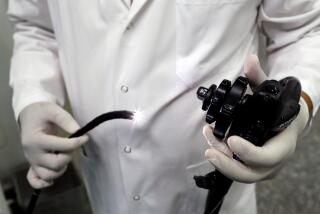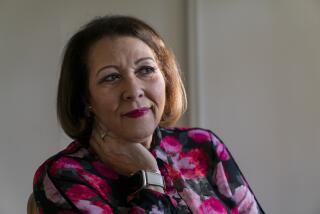Op-Ed: When screening is bad for a woman’s health

A woman waits outside the mammogram and women’s health services area at a free health clinic event at the Los Angeles Sports Arena in 2012.
- Share via
If you haven’t gotten this message already, you should heed it now: The benefits of screening for breast cancer are limited. We should be doing fewer screening mammograms, not more.
The data that support this conclusion come from studying the effects of mammography across time and place.
A couple of years ago an Oregon colleague and I reported on the effect across time. We found that the initiation of widespread screening in the United States during the 1980s was associated with a substantial increase in the number of women found with early-stage breast cancer, but it didn’t yield much of a decrease in the number found with serious late-stage cancer. And, remarkably, no change in the worst stage: The number diagnosed with life-threatening metastatic breast cancer didn’t decrease.
That so few women who ended up with serious breast cancer had their time of diagnosis advanced (to early-stage) suggests that the benefit of screening is very limited. And yet having so many additional women diagnosed with early-stage cancer suggests screening leads to a lot of overdiagnosis, unnecessary treatment and anxiety.
As to the effect across place, in an article published this month in JAMA Internal Medicine, Harvard colleagues and I reported on breast cancer in 547 counties in the United States. The study was a natural experiment: It made use of the fact that screening-mammography rates vary considerably by county.
We found that counties that screened more found significantly more breast cancer. But there was no relationship between how much a county screened for breast cancer and how likely its female residents were to die from breast cancer. In other words, once again the benefit of screening was very limited and once again it led to diagnoses of cancers that otherwise would have never bothered women.
This conclusion was further supported by data on cancer size. More screening was strongly associated with more detection of small breast cancers. But more screening was not associated with less detection of serious late-stage breast cancers.
Over time and over place, the findings are consistent: Screening is good at finding small breast cancers. Unfortunately, the small cancers it finds often seem to be those not destined to become large, deadly cancers.
Let me be clear about what I am not saying. I am not saying breast cancer is not an important disease. It is arguably the most important cancer for a nonsmoking woman to worry about. I am not saying there is no good news about breast cancer. Quite the opposite: The huge strides in breast cancer treatment represent unambiguously good news. Nor am I saying you shouldn’t get a mammogram if you notice a new breast lump. Doctors agree that mammography is a good diagnostic test; the debate is about screening mammography. And I’m not saying that screening never helps anyone. It may, but it without doubt has harms.
Given the evidence of its limited benefit, we really need to limit the harms of breast cancer screening.
The most frequent harm is the false alarm. To be sure, the effect of a false alarm on a woman is highly variable, ranging from a minor inconvenience (simply requiring a repeat exam) to a seemingly endless cycle of repetitive testing that, although it never detects cancer, also never comes back “normal.” According to data from the Breast Cancer Surveillance Consortium, more than half of women will have at least one false alarm during a 10-year course of annual screening in the United States.
But a 50% rate of false alarms is neither humane nor efficient. The public health community should be outraged. Our European colleagues wince at our performance; their false-alarm rates are less than half ours. (They get less than half the false positives we do because they do a better job reading mammograms and overseeing the process.) The business community should be equally outraged: all that time and money spent for no value.
But the bigger harm is actually overdiagnosis. Women are being diagnosed with breast cancer, and receiving some combination of surgery, chemotherapy and/or radiation, when, in fact, that cancer was not destined to cause symptoms — a lump you can feel — or be life-threatening. Screening mammography is more likely to cause overdiagnosis than it is to help save lives.
Britain’s National Health Service now explicitly informs women that their chance of overdiagnosis with mammograms is about three times higher than their chance of avoiding a breast cancer death. The chances of overdiagnosis are surely higher in the U.S., where we look harder for early breast cancer.
Yet there is an entire industry devoted to looking harder still. Three-D mammography is promoted as finding 40% more breast cancer than conventional screening. The addition of ultrasound finds 50% more breast cancer than conventional screening. Adding an MRI doubles the amount of breast cancer found. And this year Mayo Clinic researchers reported finding almost four times more breast cancer using molecular breast imaging.
Looking harder isn’t the right way to combat breast cancer. What do get when we look harder? More false alarms and more overdiagnosis — with no obvious change in what we really care about: breast cancer deaths.
Why are we doing it? Having so much money on the table doesn’t help. American women and insurers are estimated to spend $8 billion annually on breast cancer screening, and that’s before the adoption of 3-D mammography. Lawyers don’t help either; doctors who might counsel fewer mammograms or be less aggressive in pursuing breast abnormalities are afraid of lawsuits in the few instances in which serious cancer later develops.
But the biggest problem seems to be a lack of leadership in the mammography community. While their colleagues in other areas of radiology are working to mitigate false alarms and overdiagnosis in lung cancer screening and in the evaluation of thyroid nodules and small kidney masses, a small, vocal group of mammographers seems content to dismiss the problems with breast cancer screening.
They shouldn’t be able to drown out the facts: More mammograms do not promote women’s health.
H. Gilbert Welch is a professor of medicine at the Dartmouth Institute for Health Policy and Clinical Practice and the author of “Less Medicine, More Health: 7 Assumptions that Drive Too Much Medical Care.”
Follow the Opinion section on Twitter @latimesopinion and Facebook
More to Read
A cure for the common opinion
Get thought-provoking perspectives with our weekly newsletter.
You may occasionally receive promotional content from the Los Angeles Times.








